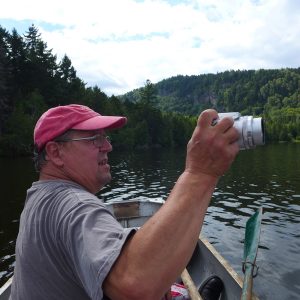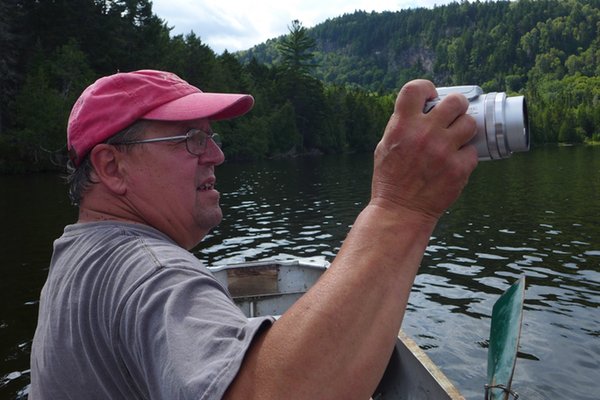“I began to paint what was important to me
and what I loved instead of what was cool.”
Interview by Jennifer Nelson, WTP Feature Writer

Alan Bray studied at the Art Institute of Boston and the University of Southern Maine. He received his Master’s degree in painting from the Villa Schifanoia in Florence, Italy, in 1973. He has had over twenty solo exhibitions including at the Farnsworth Art Museum and Caldbeck Gallery in Rockland, Maine. His public collections have appeared at the Portland Museum of Art, Memphis Cancer Center, and Kohlberg, Kravis & Roberts’ offices in Menlo Park, California. According to The New Yorker, “Alan Bray’s landscapes evoke nature’s majesty but drain away its wildness, suggesting something of the poise and repose of Giotto or Mantegna.”
Nelson: Your paintings have been praised for capturing the essence of Maine, the same way Andrew Wyeth and Winslow Homer once did in their own works. Were these some of the artists who inspired you? And from what other artists or actual works have you drawn inspiration?
Bray: I dutifully ignored both Wyeth and Homer as an art student in the ’60s. It was in Italy that I became enamored of artists like Lorenzetti, Fra Angelico, Simone Martini, Giotto, and others of that time. It was partly the unexpected qualities of pure primary colors, hard edges, the rudimentary perspective and the resulting compositional inventiveness that looked so modern and so alluring to me. It was also the awareness that my own work lacked any of the spiritual depth that was so compelling in those artists. I began to paint what was important to me and what I loved instead of what was cool. I began by painting my hometown from memory, street by street.
Nelson: Can you elaborate on how your childhood has impacted your artwork?

Bray: I grew up in a small town in central Maine with two brothers and a single dad. We were very self-sufficient at an early age and, with friends, spent most of our time out of doors hiking, camping, fishing, and playing. We were avid explorers who inherited a keen interest in and respect for nature. We also learned a healthy respect for work, and that has been invaluable in developing the discipline required to make art over a long period of time.
Nelson: Can you describe your painting process, including your choice of casein as a medium and how much time you spend on each piece?
Bray: I began working with various tempered pigment methods in Italy. Casein immediately suited me in a way no other medium ever had. It is more like drawing than painting, in that the image is built by layering multiple strokes and cross hatchings to eventually arrive at the finished form and color. It dries instantly so one can keep working without waiting for things to dry. It is similar to watercolor but each layer is impervious to water so there is no bleeding. This quality allows for the extraordinary luminosity of the medium.
Nelson: Have you experimented with other mediums?
Bray: Egg tempera, oils, and gauche. I continue to use Sumi inks, charcoal, graphite, and watercolor when working on site.

Nelson: Your painting “Footbridge” reminds me of Neil Welliver’s snow paintings. You capture the essence of a wintry day with such realism that it almost seems as if one is looking out a window—you meticulously paint the drifting of snow, branching of trees, and meandering flow of water. Can you comment on the importance of being intimately familiar with the landscape in order to achieve these results?
Bray: Writers have been a larger influence for me than painters and none more so perhaps than Gaston Bachelard. It was his The Poetics of Space that showed me a way to look at the natural world that was not about “scenery” but was about phenomena. This was extremely liberating and I began to look at the workings of nature in a new light and realized you could make a painting about water moving around a rock or snow drifting in a field and that could be the subject. I paint things that are close to me. I paint things I see every day and then one day, for some reason, it reappears as something new and sublime. I’ve tried to paint some of the places I have traveled, like Hadrian’s Wall and Newfoundland, where the Appalachian Mountains come back out of the sea, and I have done drawings and sketches there but I’ve never painted from them. It was like a tourist’s knowledge of a place and I need a more intimate and holistic connection to proceed it seems.
Nelson: You have been called “the visual poet laureate of nature, reclaiming central Maine even as man attempts to suburbanize it.” Some have described your artwork as meditative. Can you comment on how your paintings aim to tell stories?
Bray: I tend to paint things that I’ve thought about for some time. Knowing it will be a month-long process, or more, I need to be convinced that it will stay interesting. It is usually a new way of seeing it, or another idea that attaches itself, that compels me to make the painting. The best paintings reveal themselves slowly and often evolve in ways that surprise me. They let me know what they want to be about as it’s not always clear at the outset. I don’t often think of them as telling stories but as so many of them are poised on the verge of the natural and manmade world it seems natural that they would become vessels for one’s own stories.

Nelson: How did your stay in Florence, Italy, where you earned a graduate degree in painting, influence your artwork?
Bray: My time in Italy was a priceless gift. Not only the magnificent surroundings of art and architecture but the camaraderie of a group of young Italian artists who were friends of one of my professors. My wife and son and I lived with my painting teacher and his family in a farm house in the country, and we became part of the culture in a way we might not have otherwise. Hanging around with this group of artists gave me a modern perspective that was often at odds with history. I think this gave me a richer sense about being an artist and about the weight of history.
Nelson: Where do you see your artwork headed in the future?
Bray: Bachelard says about nature that, “there is no word for the sense that you are a part of what you are looking at.” I have been looking for an image that would achieve that immersion in the absence of a word. It seems more important now than ever to find ways to connect people to the natural world so I suppose I will continue to try and paint the world that we share and scrape down even closer to the bones of things.
Copyright 2018 Woven Tale Press LLC. All Rights Reserved.

